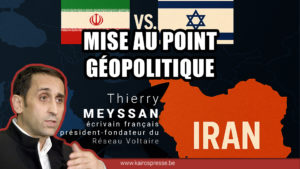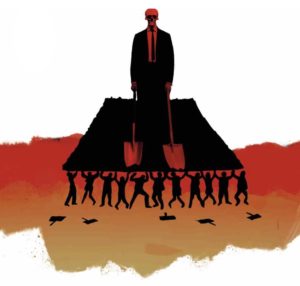Le président chinois Xi Jinping a qualifié d’«historiques» toutes les décisions majeures prises lors du 15ème sommet des BRICS en Afrique du Sud. On peut considérer qu’il s’agit là d’un euphémisme.
Il faudra du temps pour que le Sud mondial, ou la Majorité mondiale, ou le «Globe mondial» (copyright président Loukachenko), sans parler de l’Occident collectif stupéfait, saisisse pleinement l’énormité des nouveaux enjeux stratégiques.
Le président Poutine, pour sa part, a qualifié les négociations sur l’expansion des BRICS de très difficiles. On commence à avoir une idée relativement précise de ce qui s’est réellement passé sur la table à Johannesburg.
L’Inde voulait trois nouveaux membres. La Chine en voulait jusqu’à 10. Un compromis a finalement été trouvé, avec 6 membres : L’Égypte, l’Iran, l’Arabie saoudite, les Émirats arabes unis (EAU), l’Argentine et l’Éthiopie.
Il s’agit donc désormais des BRICS 11. Et ce n’est qu’un début. À partir de la présidence tournante russe des BRICS, le 1er janvier 2024, d’autres partenaires seront progressivement inclus, et très certainement une nouvelle série de membres à part entière sera annoncée lors du sommet des BRICS 11 à Kazan en octobre de l’année prochaine.
Nous pourrions donc bientôt atteindre les BRICS 20 – en route vers les BRICS 40. Le G7, à toutes fins utiles, glisse vers l’oubli.
Sur la création d’un Nouvel Ordre Mondial par les BRICS :
Les diplomates des BRICS regardent parfois les défis qui les attendent et se disent : «Pouvons-nous y arriver ? C’est tellement compliqué, tellement complexe…. si vous les faites interagir de plus en plus étroitement, alors ils pourront relever les défis, mais dans une atmosphère de coopération, de respect mutuel et de respect de la souveraineté de chacun, ce qui est le contraire absolu de l’ordre international fondé sur des règles», a déclaré à Sputnik Pepe Escobar, analyste géopolitique et écrivain.
Mais commençons par le commencement. À la table fatidique de Johannesburg, la Russie a soutenu l’Égypte. La Chine a tout misé sur la magie du golfe Persique : l’Iran, les Émirats arabes unis et les Saoudiens. Cela va de soi : L’Iran et la Chine sont déjà engagés dans un partenariat stratégique et Riyad accepte déjà de payer l’énergie en yuans.
Le Brésil et la Chine ont soutenu l’Argentine, le voisin en difficulté du Brésil, qui court le risque de voir son économie entièrement dollarisée, et qui est également un fournisseur clé de matières premières pour Pékin. L’Afrique du Sud a soutenu l’Éthiopie. L’Inde, pour une série de raisons très complexes, n’était pas vraiment à l’aise avec trois membres arabes/musulmans (Arabie saoudite, Émirats arabes unis, Égypte). La Russie a apaisé les craintes de New Delhi.
Tout ce qui précède respecte les principes géographiques et marque l’idée que les BRICS représentent le Sud mondial. Mais cela va bien plus loin, mêlant stratégie astucieuse et realpolitik sans état d’âme.
L’Inde a été rassurée parce que le ministre des Affaires étrangères russe Sergueï Lavrov, présent à la table des négociations de Johannesburg au nom du président Poutine, et très respecté par New Delhi, a parfaitement compris qu’une nouvelle monnaie unique des BRICS est encore loin d’être une réalité. Ce qui compte vraiment, à court et à moyen terme, c’est l’expansion du commerce intra-BRICS dans leurs monnaies nationales.
C’est ce qu’a souligné la présidente de la Nouvelle Banque de développement (NDB), Dilma Rousseff, dans son rapport aux hôtes du sommet sud-africain, alors même que le président brésilien Lula soulignait une fois de plus l’importance de mettre en place un groupe de travail pour discuter d’une monnaie des BRICS.
Lavrov a compris que New Delhi était absolument terrifiée à l’idée de subir des sanctions secondaires de la part des États-Unis, au cas où son rôle au sein des BRICS deviendrait trop ambitieux. Le Premier ministre Modi fait essentiellement le lien entre les BRICS et l’obsession impériale totalement artificielle contenue dans la terminologie «Indo Pacifique», qui masque un nouvel endiguement de la Chine. Les psychopathes néo-con straussiens en charge de la politique étrangère américaine sont déjà furieux que l’Inde achète des tonnes de pétrole russe à prix réduit.
Le soutien de New Delhi à une nouvelle monnaie des BRICS serait interprété à Washington comme une guerre commerciale totale – et la démence des sanctions s’ensuivrait. En revanche, le ministre des Affaires étrangères de l’Arabie saoudite n’en a cure : il est l’un des principaux producteurs d’énergie, et non un consommateur comme l’Inde, et l’une de ses priorités est de courtiser pleinement son principal client énergétique, Pékin, et d’ouvrir la voie au pétroyuan.
Un seul mouvement stratégique suffit
Passons maintenant aux enjeux stratégiques. À toutes fins utiles, en termes eurasiens, les BRICS 11 sont désormais en passe de régner sur la route maritime arctique, le corridor international de transport nord-sud (INSTC), les corridors est-ouest de la BRI, le golfe Persique, la mer Rouge et le canal de Suez.
Cela permet de combiner plusieurs corridors terrestres avec plusieurs nœuds des Routes de la soie maritimes. L’intégration est presque totale dans le Heartland et le Rimland. Tout cela en un seul mouvement stratégique sur l’échiquier géopolitique/géoéconomique.
Bien plus qu’une augmentation du PIB collectif des BRICS 11 à 36% du total mondial (déjà plus important que celui du G7), le groupe englobant désormais 47% de la population mondiale, la principale percée géopolitique et géoéconomique est la manière dont les BRICS 11 sont sur le point de littéralement casser la baraque sur les fronts des marchés de l’énergie et des matières premières.
En intégrant l’Iran, l’Arabie saoudite et les Émirats arabes unis, les BRICS 11 s’imposent instantanément comme une puissance pétrolière et gazière. Selon InfoTEK, les BRICS 11 contrôlent actuellement 39% des exportations mondiales de pétrole, 45,9% des réserves prouvées et au moins 47,6% de tout le pétrole produit dans le monde.
Avec les BRICS 11 qui pourraient notamment inclure le Venezuela, l’Algérie et le Kazakhstan comme nouveaux membres dès 2024, ils pourraient contrôler jusqu’à 90% de l’ensemble du pétrole et du gaz échangés à l’échelle mondiale.
Corollaire inévitable : des opérations réglées en monnaies locales, sans passer par le dollar américain. Conclusion inévitable : le pétrodollar dans le coma. L’Empire du chaos et du pillage perdra son repas gratuit : le contrôle des prix mondiaux du pétrole et les moyens d’appliquer la «diplomatie» par le biais d’un tsunami de sanctions unilatérales.
Déjà à l’horizon, la symbiose directe BRICS 11-OPEC+ est inévitable. L’OPEC+ est effectivement dirigée par la Russie et l’Arabie saoudite.
Une réorientation géoéconomique bouleversante est à portée de main, impliquant tout, des routes empruntées par les chaînes d’approvisionnement mondiales et les nouvelles routes des BRICS à l’interconnexion progressive de la BRI, de la Vision 2030 saoudienne et de l’expansion portuaire massive aux Émirats arabes unis.
En choisissant l’Éthiopie, les BRICS étendent leur portée africaine sur l’exploitation minière, les minéraux et les métaux. L’Éthiopie est riche en or, platine, tantale, cuivre, niobium et offre un vaste potentiel dans l’exploration du pétrole et du gaz naturel. L’Arabie saoudite et les Émirats arabes unis sont également impliqués dans l’exploitation minière.
Tout cela laisse présager une intégration rapide et progressive de l’Afrique du Nord et de l’Asie occidentale.
La diplomatie, un atout majeur
Le nouveau choc des BRICS, dans le domaine de l’énergie, est un contrepoint historique au choc pétrolier de 1973, après lequel Riyad a commencé à se vautrer dans les pétrodollars. Aujourd’hui, l’Arabie saoudite, sous la houlette de MbS, opère un changement tectonique et est en train de s’aligner stratégiquement sur la Russie, la Chine, l’Inde et l’Iran.
Un coup d’État diplomatique n’est même pas un début de description. Il s’agit de la deuxième étape du rapprochement entre Riyad et Téhéran, initié par la Russie et finalisé par la Chine, qui a récemment été scellé à Pékin. Le leadership stratégique Russie Chine, qui travaille patiemment en synchronisation, n’a jamais perdu de vue la balle.
Comparez maintenant avec les «stratégies» collectives de l’Occident, telles que le plafonnement des prix du pétrole imposé par le G7. En fait, la «coalition des volontaires» du G7 a imposé elle-même un plafonnement des prix du brut russe importé par voie maritime. Le résultat est qu’ils ont dû commencer à acheter beaucoup plus de produits pétroliers aux pays du Sud mondial qui ont ignoré le plafonnement des prix et ont dûment augmenté leurs achats de brut russe.
Devinez qui sont les deux premiers : la Chine et l’Inde, membres des BRICS.
Après s’être vautré dans plusieurs phases de déni, l’Occident collectif pourrait – ou non – réaliser que c’est un rêve insensé que d’essayer de «découpler» la partie de l’économie mondiale dominée par l’Occident de la Chine, quoi qu’en dise Washington.
Les BRICS 11 montrent aujourd’hui, de manière graphique, comment le «Sud mondial/Majorité mondiale/Globe mondial» est plus non aligné sur l’Occident qu’il ne l’a jamais été dans l’histoire récente.
Soit dit en passant, le président du G77, le dirigeant cubain Diaz-Canel, était présent au sommet des BRICS en tant que représentant du nouveau mouvement des non-alignés de facto : le G77 comprend en fait pas moins de 134 pays. La plupart d’entre eux sont africains. À Johannesburg, Xi Jinping a rencontré en personne les dirigeants de la plupart d’entre eux.
L’Occident, pris de panique, les considère tous comme «dangereux». Le dernier refuge est donc, comme on peut s’y attendre, rhétorique : «découplage», «dé-risquage» et autres idioties du même genre.
Mais cela peut aussi s’avérer dangereux d’un point de vue pratique. Comme lors du tout premier sommet trilatéral à Camp David le 18 août entre l’Empire et deux vassaux asiatiques, le Japon et la Corée du Sud. Cela peut être interprété comme le premier pas vers une OTAN asiatique militaro-politique encore plus toxique que le Quad ou l’AUKUS, obsédée par la volonté de contenir simultanément la Chine, la Russie et la RPDC.
Le dépassement collectif du Nord mondial
L’ONU répertorie 152 pays dans le monde comme «pays en développement». C’est à eux que s’adresse le groupe BRICS 11, car ils dépassent les pays du Nord sur tous les plans, de la croissance démographique à la contribution globale à la croissance du PIB mondial mesurée en PPA.
Au cours des dix dernières années, depuis l’annonce de la BRI à Astana puis à Jakarta, les institutions financières chinoises ont prêté près de 1000 milliards de dollars pour des projets de connectivité des infrastructures dans tout le Sud mondial. Le prochain forum de la BRI à Pékin marquera un nouvel élan. C’est la symbiose BRI-BRICS.
Lors du G20 de l’année dernière, la Chine a été le premier pays à faire pression pour l’inclusion de l’Union africaine (UA), qui compte 55 membres. Cela pourrait se produire lors du sommet du G20 le mois prochain à New Delhi ; dans ce cas, la représentation du Sud mondial sera proche de la parité avec celle du Nord.
Les affirmations selon lesquelles Pékin organiserait une conspiration malveillante pour faire des BRICS une arme contre le G7 sont infantiles. La realpolitik – et les indicateurs géoéconomiques – dictent les termes, configurant le choc du nouveau : l’insignifiance irréversible du G7 avec la montée en puissance des BRICS 11.
Pepe Escobar
Source : Sputnik Globe
Traduction Réseau International






